JamesJoyce乔伊斯简介
- 格式:doc
- 大小:213.50 KB
- 文档页数:10
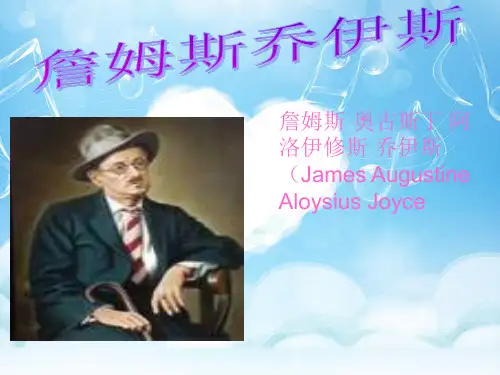
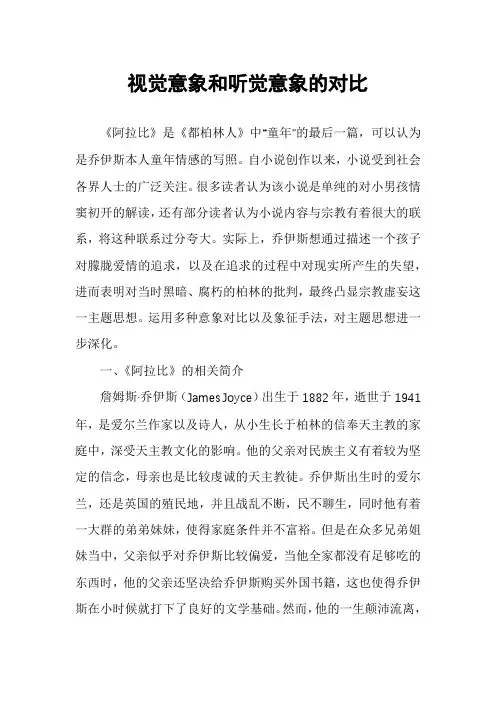
视觉意象和听觉意象的对比《阿拉比》是《都柏林人》中“童年”的最后一篇,可以认为是乔伊斯本人童年情感的写照。
自小说创作以来,小说受到社会各界人士的广泛关注。
很多读者认为该小说是单纯的对小男孩情窦初开的解读,还有部分读者认为小说内容与宗教有着很大的联系,将这种联系过分夸大。
实际上,乔伊斯想通过描述一个孩子对朦胧爱情的追求,以及在追求的过程中对现实所产生的失望,进而表明对当时黑暗、腐朽的柏林的批判,最终凸显宗教虚妄这一主题思想。
运用多种意象对比以及象征手法,对主题思想进一步深化。
一、《阿拉比》的相关简介詹姆斯·乔伊斯(James Joyce)出生于1882年,逝世于1941年,是爱尔兰作家以及诗人,从小生长于柏林的信奉天主教的家庭中,深受天主教文化的影响。
他的父亲对民族主义有着较为坚定的信念,母亲也是比较虔诚的天主教徒。
乔伊斯出生时的爱尔兰,还是英国的殖民地,并且战乱不断,民不聊生,同时他有着一大群的弟弟妹妹,使得家庭条件并不富裕。
但是在众多兄弟姐妹当中,父亲似乎对乔伊斯比较偏爱,当他全家都没有足够吃的东西时,他的父亲还坚决给乔伊斯购买外国书籍,这也使得乔伊斯在小时候就打下了良好的文学基础。
然而,他的一生颠沛流离,辗转于各大城市,但对文学却矢志不渝,勤奋写作,为世人留下了宝贵的精神财富。
《阿拉比》是《都柏林人》中的一篇,乔伊斯在1904年才开始创作《都柏林人》,这是他久负盛名的短篇小说集,可以称得上是20世纪整个西方最为著名的短片小说集。
该小说集主要是取材于二三十年代的都柏林,深刻揭示了中下层人民的生活,通过将十五个故事汇集起来,就像一幅印象主义的绘画,以简练的笔触,浮现出苍凉世态。
其中《阿拉比》中主要描写的是住在北理齐的男孩希望获得他朋友姐姐的芳心,围绕这个线索展开小说描写。
他承诺要给他朋友的姐姐在阿拉比集市买一些礼物,当他姑父答应给他钱后的几天,一直想着给那女孩买什么礼物。
然而,在去集市的那天,姑父回家比较晚,当把钱给这个男孩时,集市很多店都关门了,仅剩的几家店里东西又太贵,已经超过了他的购买能力,在阿拉比集市他得到的只是失望。



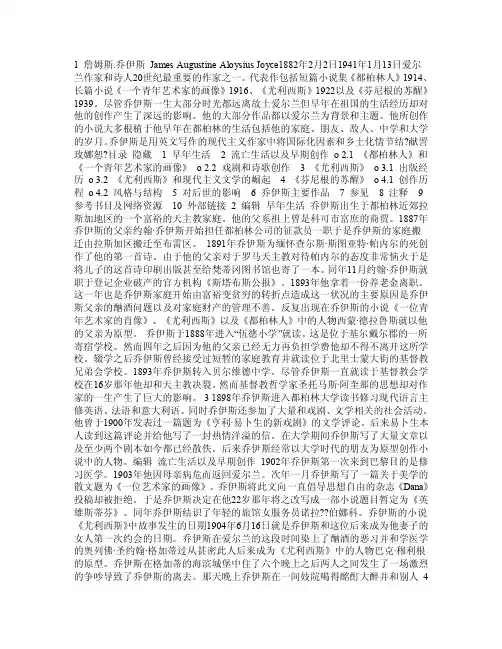
1 詹姆斯.乔伊斯James Augustine Aloysius Joyce1882年2月2日1941年1月13日爱尔兰作家和诗人20世纪最重要的作家之一。
代表作包括短篇小说集《都柏林人》1914、长篇小说《一个青年艺术家的画像》1916、《尤利西斯》1922以及《芬尼根的苏醒》1939。
尽管乔伊斯一生大部分时光都远离故土爱尔兰但早年在祖国的生活经历却对他的创作产生了深远的影响。
他的大部分作品都以爱尔兰为背景和主题。
他所创作的小说大多根植于他早年在都柏林的生活包括他的家庭、朋友、敌人、中学和大学的岁月。
乔伊斯是用英文写作的现代主义作家中将国际化因素和乡土化情节结?献詈玫娜恕?目录隐藏 1 早年生活 2 流亡生活以及早期创作o 2.1 《都柏林人》和《一个青年艺术家的画像》o 2.2 戏剧和诗歌创作 3 《尤利西斯》o 3.1 出版经历o 3.2 《尤利西斯》和现代主义文学的崛起 4 《芬尼根的苏醒》o 4.1 创作历程o 4.2 风格与结构 5 对后世的影响 6 乔伊斯主要作品7 参见8 注释9 参考书目及网络资源10 外部链接 2 编辑早年生活乔伊斯出生于都柏林近郊拉斯加地区的一个富裕的天主教家庭。
他的父系祖上曾是科可市富庶的商贾。
1887年乔伊斯的父亲约翰·乔伊斯开始担任都柏林公司的征款员一职于是乔伊斯的家庭搬迁由拉斯加区搬迁至布雷区。
1891年乔伊斯为缅怀查尔斯·斯图亚特·帕内尔的死创作了他的第一首诗。
由于他的父亲对于罗马天主教对待帕内尔的态度非常恼火于是将儿子的这首诗印刷出版甚至给梵蒂冈图书馆也寄了一本。
同年11月约翰·乔伊斯就职于登记企业破产的官方机构《斯塔布斯公报》。
1893年他拿着一份养老金离职。
这一年也是乔伊斯家庭开始由富裕变贫穷的转折点造成这一状况的主要原因是乔伊斯父亲的酗酒问题以及对家庭财产的管理不善。
反复出现在乔伊斯的小说《一位青年艺术家的肖像》、《尤利西斯》以及《都柏林人》中的人物西蒙·德拉鲁斯就以他的父亲为原型。

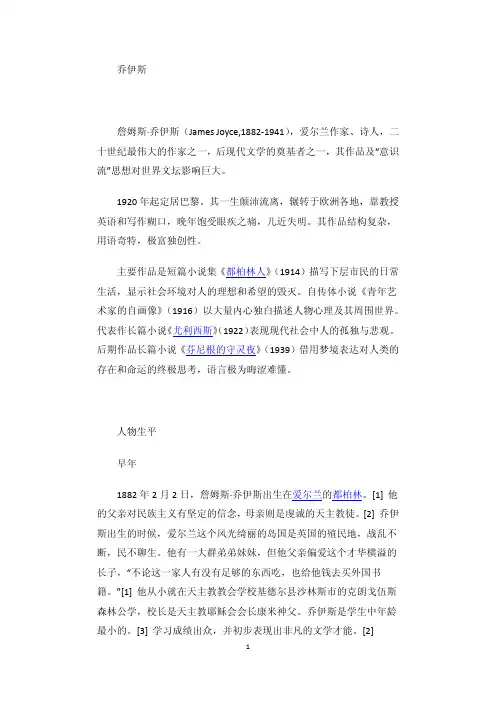
詹姆斯∙乔伊斯(James Joyce,1882‐1941),爱尔兰作家、诗人,二十世纪最伟大的作家之一,后现代文学的奠基者之一,其作品及“意识流”思想对世界文坛影响巨大。
1920年起定居巴黎。
其一生颠沛流离,辗转于欧洲各地,靠教授英语和写作糊口,晚年饱受眼疾之痛,几近失明。
其作品结构复杂,用语奇特,极富独创性。
主要作品是短篇小说集《都柏林人》(1914)描写下层市民的日常生活,显示社会环境对人的理想和希望的毁灭。
自传体小说《青年艺术家的自画像》(1916)以大量内心独白描述人物心理及其周围世界。
代表作长篇小说《尤利西斯》(1922)表现现代社会中人的孤独与悲观。
后期作品长篇小说《芬尼根的守灵夜》(1939)借用梦境表达对人类的存在和命运的终极思考,语言极为晦涩难懂。
人物生平早年1882年2月2日,詹姆斯∙乔伊斯出生在爱尔兰的都柏林。
[1] 他的父亲对民族主义有坚定的信念,母亲则是虔诚的天主教徒。
[2] 乔伊斯出生的时候,爱尔兰这个风光绮丽的岛国是英国的殖民地,战乱不断,民不聊生。
他有一大群弟弟妹妹,但他父亲偏爱这个才华横溢的长子,“不论这一家人有没有足够的东西吃,也给他钱去买外国书籍。
”[1] 他从小就在天主教教会学校基德尔县沙林斯市的克朗戈伍斯森林公学,校长是天主教耶稣会会长康米神父。
乔伊斯是学生中年龄最小的。
[3] 学习成绩出众,并初步表现出非凡的文学才能。
[2]1893年经康米神父介绍,乔伊斯于四月六日入了贝尔维迪尔公学三年级。
这座学校也是耶稣会所创办的,他一度想当神父。
十九世纪以来,在都柏林形成了以叶芝、格雷戈里夫人及辛格为中心的爱尔兰文艺复兴运动,他直接间接受影响。
通过友人,[3] 他也受到爱尔兰民族独立运动的影响。
然而给予他更强烈影响的是,十九世纪末出现在欧洲文学中的自由思想。
中学毕业前,他就对宗教信仰产生了怀疑。
1897年获全爱尔兰最佳作文奖。
1898年乔伊斯进入都柏林大学专攻哲学和语言。
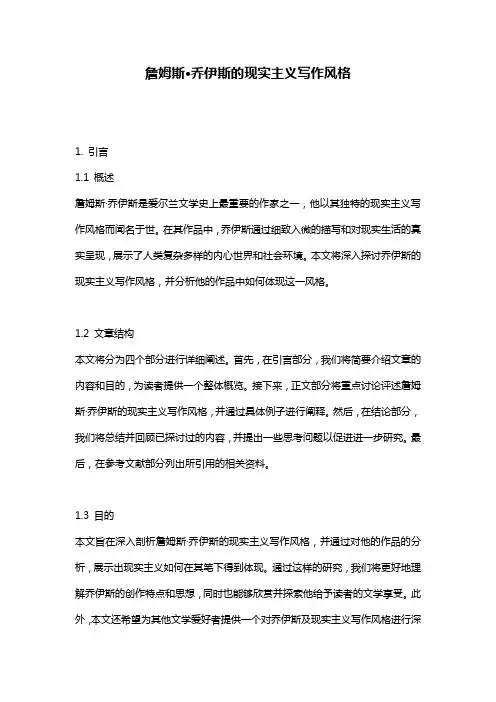
詹姆斯·乔伊斯的现实主义写作风格1. 引言1.1 概述詹姆斯·乔伊斯是爱尔兰文学史上最重要的作家之一,他以其独特的现实主义写作风格而闻名于世。
在其作品中,乔伊斯通过细致入微的描写和对现实生活的真实呈现,展示了人类复杂多样的内心世界和社会环境。
本文将深入探讨乔伊斯的现实主义写作风格,并分析他的作品中如何体现这一风格。
1.2 文章结构本文将分为四个部分进行详细阐述。
首先,在引言部分,我们将简要介绍文章的内容和目的,为读者提供一个整体概览。
接下来,正文部分将重点讨论评述詹姆斯·乔伊斯的现实主义写作风格,并通过具体例子进行阐释。
然后,在结论部分,我们将总结并回顾已探讨过的内容,并提出一些思考问题以促进进一步研究。
最后,在参考文献部分列出所引用的相关资料。
1.3 目的本文旨在深入剖析詹姆斯·乔伊斯的现实主义写作风格,并通过对他的作品的分析,展示出现实主义如何在其笔下得到体现。
通过这样的研究,我们将更好地理解乔伊斯的创作特点和思想,同时也能够欣赏并探索他给予读者的文学享受。
此外,本文还希望为其他文学爱好者提供一个对乔伊斯及现实主义写作风格进行深入了解和研究的参考基础。
2. 正文:詹姆斯·乔伊斯(James Joyce)是20世纪爱尔兰最重要的现代主义作家之一,他以其独特而深入的现实主义写作风格而闻名于世。
在他的作品中,乔伊斯以精细入微的描写和复杂的内心独白来展现人物形象和情感体验。
以下将详细探讨詹姆斯·乔伊斯的现实主义写作风格。
3.1 詹姆斯·乔伊斯简介詹姆斯·奥古斯汀·艾奥納奇欧斯·乔伊斯于1882年出生在都柏林市,是一个拥有多才多艺且充满争议的作家。
他接受过传统教育,但同时也受到了新思潮和国际文化的影响。
这种跨文化交融使得乔伊斯能够将不同文化元素融入自己的作品中,并赋予其独特的风格。
3.2 现实主义写作风格的定义与特点现实主义是一种文学流派,强调对真实生活和社会现象的描绘。
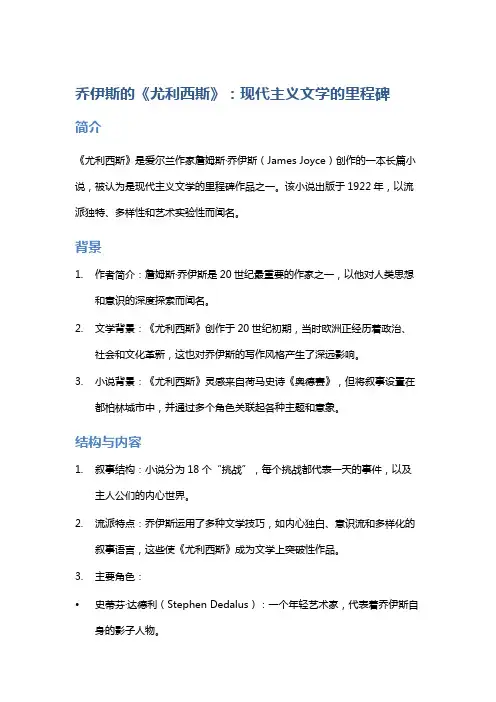
乔伊斯的《尤利西斯》:现代主义文学的里程碑简介《尤利西斯》是爱尔兰作家詹姆斯·乔伊斯(James Joyce)创作的一本长篇小说,被认为是现代主义文学的里程碑作品之一。
该小说出版于1922年,以流派独特、多样性和艺术实验性而闻名。
背景1.作者简介:詹姆斯·乔伊斯是20世纪最重要的作家之一,以他对人类思想和意识的深度探索而闻名。
2.文学背景:《尤利西斯》创作于20世纪初期,当时欧洲正经历着政治、社会和文化革新,这也对乔伊斯的写作风格产生了深远影响。
3.小说背景:《尤利西斯》灵感来自荷马史诗《奥德赛》,但将叙事设置在都柏林城市中,并通过多个角色关联起各种主题和意象。
结构与内容1.叙事结构:小说分为18个“挑战”,每个挑战都代表一天的事件,以及主人公们的内心世界。
2.流派特点:乔伊斯运用了多种文学技巧,如内心独白、意识流和多样化的叙事语言,这些使《尤利西斯》成为文学上突破性作品。
3.主要角色:•史蒂芬·达德利(Stephen Dedalus):一个年轻艺术家,代表着乔伊斯自身的影子人物。
•利奥波德·布鲁姆(Leopold Bloom):一个中年广告商,他经历了一系列奇妙而现实的冒险。
4.主题与意象:•人类存在与意义:小说对生命、爱情、性欲、宗教等议题进行深入探索。
•都柏林城市景观:都柏林作为背景地点,在小说中象征着城市生活的方方面面。
影响与评论1.文学影响:《尤利西斯》带来了现代主义文学的革新,对后来的作家产生了重大影响。
许多学者将其视为20世纪最重要的小说之一。
2.文化影响:该小说引发了广泛的文学评论和讨论,激发了人们对语言、意识和文化认同的思考。
3.评论观点:有些评论家称赞《尤利西斯》的创新性和深度,而另一些则批评其难以理解的叙事风格和复杂性。
结论作为现代主义文学的里程碑,《尤利西斯》在创作形式、主题选择和语言运用方面都有着重要地位。
它不仅是乔伊斯个人风格的体现,也成为了20世纪文学史上的经典之作。

James Joyce (1882-1941), Irish novelist, noted for his experimental use of language in such works as Ulysses (1922) and Finnegans Wake (1939). Joyce's technical innovations in the art of the novel include an extensive use of interior monologue; he used a complex network of symbolic parallels drawn from the mythology, history, and literature, and created a unique language of invented words, puns, and allusions.詹姆斯·奥古斯汀·艾洛依休斯·乔伊斯(James Augustine Aloysius Joyce),(1882年2月2曰——1941年1月13曰),爱尔兰作家和诗人,20世纪最重要的作家之一。
代表作包括短篇小说集《都柏林人》(1914)、长篇小说《一个青年艺术家的画像》(1916)、《尤利西斯》(1922)以及《芬尼根的苏醒》(1939)。
尽管乔伊斯一生大部分时光都远离故土爱尔兰,但早年在祖国的生活经历却对他的创作产生了深远的影响。
他的大部分作品都以爱尔兰为背景和主题。
他所创作的小说大多根植于他早年在都柏林的生活,包括他的家庭、朋友、敌人、中学和大学的岁月。
乔伊斯是用英文写作的现代主义作家中将国际化因素和乡土化情节结合最好的人。
James Joyce was born in Dublin, on February 2, 1882, as the son of John Stanislaus Joyce, an impoverished gentleman, who had failed in a distillery business and tried all kinds of professions, including politics and tax collecting. Joyce's mother, Mary Jane Murray, was ten years younger than her husband. She was an accomplished pianist, whose life was dominated by the Roman Catholic Church. In spite of their poverty, the family struggled to maintain a solid middle-class facade.乔伊斯出生于都柏林近郊拉斯加地区的一个富裕的天主教家庭。
James Joyce乔伊斯简介1882-1941 短篇小说:Dubiners都柏林人长篇小说:A Portrait of the Artist as a Young Man青年艺术家的画像;Ulysess尤利西斯;Finnegans Wake芬尼根的觉醒Introductionin full James Augustine Aloysius Joyceborn Feb. 2, 1882, Dublin, Ire.died Jan. 13, 1941, Zürich, Switz.•James Joyce, oil on canvas by Jacques-Émile Blanche, 1935.Irish novelist noted for his experimental use of language and exploration of new literary methods in such large works of fiction as Ulysses(1922) and Finnegans Wake (1939).Early lifeJoyce, the eldest of 10 children in his family to survive infancy, was sent at age six to Clongowes Wood College, a Jesuit boarding school that has been described as “the Eton of Ireland.” But his father was not the man to stay affluent for long; he drank, neglected his affairs, andborrowed money from his office, and his family sank deeper and deeper into poverty, the children becoming accustomed to conditions of increasing sordidness. Joyce did not return to Clongowes in 1891; instead he stayed at home for the next two years and tried to educate himself, asking his mother to check his work. In April 1893 he and his brother Stanislaus were admitted, without fees, toBelvedere College, a Jesuit grammar school in Dublin. Joyce did well there academically and was twice elected president of the Marian Society, a position virtually that of head boy. He left, however, under a cloud, as it was thought (correctly) that he had lost his Roman Catholic faith.He entered University College, Dublin, which was then staffed by Jesuit priests. There he studied languages and reserved his energies for extracurricular activities, reading widely—particularly in books not recommended by the Jesuits—and taking an active part in the college's Literary and Historical Society. Greatly admiring Henrik Ibsen, he learned Dano-Norwegian to read the original and had an article, Ibsen's New Drama—a review of the play When We Dead Awaken—published in the London Fortnightly Review in 1900 just after his 18th birthday. This early success confirmed Joyce in his resolution to become a writer and persuaded his family, friends, and teachers that the resolution was justified. In October 1901 he published an essay, "The Day of the Rabblement," attacking the Irish Literary Theatre (later the Dublin Abbey Theatre) for catering to popular taste.Joyce was leading a dissolute life at this time but worked sufficiently hard to pass his final examinations, matriculating with “second-class honours in Latin” and obtaining the degree of B.A. on Oct. 31, 1902. Never did he relax his efforts to master the art of writing. He wrote verses and experimented with short prose passages that he called “epiphanies,”a word that Joyce used to describe his accounts of moments when the real truth about some person or object was revealed. To support himself while writing, he decided to become a doctor, but, after attending a few lectures in Dublin, he borrowed what money he could and went to Paris, where he abandoned the idea of medical studies, wrote some book reviews, and studied in the Sainte-Geneviève Library.Recalled home in April 1903 because his mother was dying, he tried various occupations, including teaching, and lived at various addresses, including the Martello Tower at Sandycove, now Ireland's Joyce Museum. He had begun writing a lengthy naturalistic novel, Stephen Hero, based on the events of his own life, when in 1904 George Russell offered £1 each for some simple short stories with an Irish background to appear in a farmers' magazine,The Irish Homestead. In response Joyce began writing the stories published as Dubliners(1914). Three stories, "The Sisters," "Eveline," and "After the Race," had appeared under the pseudonym Stephen Dedalus before the editor decided that Joyce's work was not suitable for his readers. Meanwhile Joyce had met a girl named Nora Barnacle, with whom he fell in love on June 16, the day that he chose as what is known as “Bloomsday” (the day of his novel Ulysses). Eventually he persuaded her to leave Ireland with him, although he refused, on principle, to go through a ceremony of marriage.Early travels and worksJoyce and Nora left Dublin together in October 1904. Joyce obtained a position in the Berlitz School, Pola, Austria-Hungary, working in his spare time at his novel and short stories. In 1905 they moved to Trieste, where James's brother Stanislaus joined them and where their children, George and Lucia, were born. In 1906–07, for eight months, he worked at a bank in Rome, disliking almost everything he saw. Ireland seemed pleasant by contrast; he wrote to Stanislaus that he had not given credit in his stories to the Irish virtue of hospitality and began to plan a new story, "The Dead." The early stories were meant, he said, to show the stultifying inertia and social conformity from which Dublin suffered, but they are written with a vividness that arises from his success in making every word and every detail significant. His studies in European literature had interested him in both the Symbolists and the Realists; his work began to show a synthesis of these two rival movements. He decided that Stephen Hero lacked artistic control and form and rewrote it as “a work in five chapters” under a title—A Portrait of the Artist as a Young Man—intended to direct attention to its focus upon the central figure.In 1909 he visited Ireland twice to try to publish Dubliners and set up a chain of Irish cinemas. Neither effort succeeded, and he was distressed when a former friend told him that he had shared Nora's affections in the summer of 1904. Another old friend proved this to be a lie. Joyce always felt that he had been betrayed, however, and the theme of betrayal runs through much of his later writings.When Italy declared war in 1915 Stanislaus was interned, but James and his family were allowed to go to Zürich. At first, while he gave private lessons in English and worked on the early chapters of Ulysses—which he had first thought of as another short story about a “Mr. Hunter”—his financial difficulties were great. He was helped by a large grant from Edith Rockefeller McCormick and finally by a series of grants from Harriet Shaw Weaver, editor of the Egoist magazine, which by 1930 had amounted to more than £23,000. Her generosity resulted partly from her admiration for his work and partly from her sympathy with his difficulties, for, as well as poverty, he had to contend with eye diseases that never really left him. From February 1917 until 1930 he endured a series of 25 operations for iritis, glaucoma, and cataracts, sometimes being for short intervals totally blind. Despite this he kept up his spirits and continued working, some of his most joyful passages being composed when his health was at its worst.Unable to find an English printer willing to set up A Portrait of the Artist as a Young Man for book publication, Weaver published it herself, having the sheets printed in the United States, where it was also published, on Dec. 29, 1916, by B.W. Huebsch, in advance of the English Egoist Press edition. Encouraged by the acclaim given to this, in March 1918, the American Little Review began to publish episodes from Ulysses, continuing until the work was banned in December 1920. An autobiographical novel, A Portrait of the Artist traces the intellectual and emotional development of a young man named Stephen Dedalus and ends with his decision to leave Dublin for Paris to devote his life to art. The last words of Stephen prior to his departure are thought to express the author's feelings upon the same occasion in his own life: “Welcome, O life! I go to encounter for the millionth time the reality of my experience and to forge in the smithy of my soul the uncreated conscience of my race.”UlyssesAfter World War I Joyce returned for a few months to Trieste, and then—at the invitation of Ezra Pound—in July 1920 he went to Paris. His novel Ulysses was published there on Feb. 2, 1922, by Sylvia Beach, proprietor of a bookshop called “Shakespeare and Company” Ulysses is constructed as a modern parallel to Homer's Odyssey. All of the action of the novel takes place in Dublin on a single day (June 16, 1904). The three central characters—Stephen Dedalus (the hero of Joyce's earlierPortrait of the Artist), Leopold Bloom, a Jewish advertising canvasser, and his wife, Molly Bloom—are intended to be modern counterparts of Telemachus, Ulysses, and Penelope. By the use of interior monologue Joyce reveals the innermost thoughts and feelings of these characters as they live hour by hour, passing from a public bath to a funeral, library, maternity hospital, and brothel.The main strength of Ulysses lies in its depth of character portrayal and its breadth of humour. Yet the book is most famous for its use of a variant of the interior monologue known as the “stream-of-consciousness” technique. Joyce claimed to have taken this technique from a forgotten French writer, Édouard Dujardin (1861–1949), who had used interior monologues in his novel Les Lauriers sont coupés(1888; We'll to the Woods No More), but many critics have pointed out that it is at least as old as the novel, though no one before Joyce had used it so continuously. Joyce's major innovation was to carry the interior monologue one step further by rendering, for the first time in literature, the myriad flow of impressions, half thoughts, associations, lapses and hesitations, incidental worries, and sudden impulses that form part of the individual's conscious awareness along with the trend of his rational thoughts. This stream-of-consciousness technique proved widely influential in much20th-century fiction.Sometimes the abundant technical and stylistic devices in Ulysses become too prominent, particularly in the much-praised “Oxen of the Sun” chapter (Episode 14), in which the language goes through every stage in the development of English prose from Anglo-Saxon to the present day to symbolize the growth of a fetus in the womb. The execution is brilliant, but the process itself seems ill-advised. More often the effect is to add intensity and depth, as, for example, in the “Aeolus” chapter (Episode 7) set in a newspaper office, with rhetoric as the theme. Joyce inserted into it hundreds of rhetorical figures and many references to winds—something “blows up” instead of happening, people “raise the wind” when they are getting money—and the reader becomes aware of an unusual liveliness in the very texture of the prose. The famous last chapter of the novel, in which we follow the stream of consciousness of Molly Bloom as she lies in bed, gains much of its effect from being written in eight huge unpunctuated paragraphs.Ulysses, which was already well known because of the censorship troubles, became immediately famous upon publication. Joyce had prepared for its critical reception by having a lecture given by Valery Larbaud, who pointed out the Homeric correspondences in it and that “each episode deals with a particular art or science, contains a particular symbol, represents a special organ of the human body, has its particular colour . . .proper technique, and takes place at a particular time.” Joyce never published this scheme; indeed, he even deleted the chapter titles in the book as printed. It may be that this scheme was more useful to Joyce when he was writing than it is to the reader.Finnegans Wake•James Joyce, photograph by Gisèle Freund, 1939.In Paris Joyce worked on Finnegans Wake, the title of which was kept secret, the novel being known simply as “Work in Progress” until it was published in its entirety in May 1939. In addition to his chronic eye troubles, Joyce suffered great and prolonged anxiety over his daughter's mental health. What had seemed her slight eccentricity grew into unmistakable and sometimes violent mental disorder that Joyce tried by every possible means to cure, but it became necessary finally to place her in a mental hospital near Paris. In 1931 he and Nora visited London, where they were married, his scruples on this point having yielded to his daughter's complaints.Meanwhile he wrote and rewrote sections of Finnegans Wake; often a passage was revised more than a dozen times before he was satisfied. Basically the book is, in one sense, the story of a publican in Chapelizod, near Dublin, his wife, and their three children; but Mr. Humphrey Chimpden Earwicker (often designated by variations on his initials, HCE, one form of which is “Here Comes Everybody”), Mrs. Anna Livia Plurabelle, Kevin, Jerry, and Isabel are every family of mankind, the archetypal family about whom all humanity is dreaming. The 18th-century Italian Giambattista Vico provides the basic theory that history is cyclic; to demonstrate this the book begins with the end of a sentence left unfinished on the last page. It is thousands of dreams in one. Languages merge: Anna Livia has “vlossyhair”—włosy being Polish for “hair”; “a bad of wind” blows, bâd being Turkish for “wind.” Charac ters from literature and history appear and merge and disappear as “the intermisunderstanding minds of the anticollaborators” dream on. On another level, the protagonists are the city of Dublin and the River Liffey—which flows enchantingly through the page s, “leaning with the sloothering slide of her, giddygaddy, grannyma, gossipaceous Anna Livia”—standing as representatives of the history of Ireland and, by extension, of all human history. And throughout the book Joyce himself is present, joking, mocking his critics, defending his theories, remembering his father, enjoying himself.After the fall of France in World War II (1940), Joyce took his family back to Zürich, where he died, still disappointed with the reception given to his last book.AssessmentJames Joyce's subtle yet frank portrayal of human nature, coupled with his mastery of language and brilliant development of new literary forms, made him one of the most commanding influences on novelists of the 20th century. Ulysses has come to be accepted as a major masterpiece, two of its characters, Leopold Bloom and his wife, Molly, being portrayed with a fullness and warmth of humanity unsurpassed in fiction. Joyce's A Portrait of the Artist as a Young Man is also remarkable for the intimacy of the reader's contact with the central figure and contains some astonishingly vivid passages. The 15 short stories collected in Dubliners mainly focused upon Dublin life's sordidness, but "The Dead" is one of the world's great short stories. Critical opinion remains divided over Joyce's last work, Finnegans Wake, a universal dream about an Irish family, composed in a multilingual style on many levels and aiming at a multiplicity of meanings; but, although seemingly unintelligible at first reading, the book is full of poetry and wit, containing passages of great beauty. Joyce's other works—some verse (Chamber Music, 1907; Pomes Penyeach, 1927; Collected Poems, 1936) and a play, Exiles(1918)—though competently written, added little to his international stature.James Stephen Atherton Ed.Additional ReadingA standard biography, Richard Ellmann, James Joyce, new and rev. ed. (1982), is reliable and exhaustive, while his The Consciousness of Joyce (1977, reissued 1981) examines Joyce's thought, especially his political views. Chester G. Anderson, James Joyce and His World (1967, reissued 1978), is a sympathetic study of his life and works. Harry Blamires, The Bloomsday Book(1966, reprinted 1974), is an excellent guide to Ulysses. Frank Budgen, James Joyce and the Making of Ulysses, new ed. (1960, reprinted 1972), gives an intimate account of Joyce at work. Hugh Kenner, Joyce's Voices (1978), is a provocative study of Ulysses. C.H. Peake, James Joyce, the Citizen and the Artist (1977), employs traditional literary values in criticizing Joyce's works. For the earlier works, both Marvin Magalaner, Time of Apprenticeship: The Fiction of Young James Joyce (1959, reissued 1970); and a collection of critical essays ed. by Clive Hart, James Joyce's Dubliners (1969), are useful. Emer Nolan, Joyce and Nationalism (1995), examines Joyce's connections to Ireland. Derek Attridge and Marjorie Howes (eds.), Semicolonial Joyce (2000), offers political perspectives on the author. Zack Bowen and James F. Carens (eds.), A Companion to Joyce Studies (1984), is a good handbook. Thomas Jackson Rice, James Joyce: A Guide to Research (1982), is indispensable for the serious student of Joyce.欢迎您的下载,资料仅供参考!。
James Joyce乔伊斯简介1882-1941 短篇小说:Dubiners都柏林人长篇小说:A Portrait of the Artist as a Young Man青年艺术家的画像;Ulysess尤利西斯;Finnegans Wake芬尼根的觉醒Introductionin full James Augustine Aloysius Joyceborn Feb. 2, 1882, Dublin, Ire.died Jan. 13, 1941, Zürich, Switz.•James Joyce, oil on canvas by Jacques-Émile Blanche, 1935.Irish novelist noted for his experimental use of language and exploration of new literary methods in such large works of fiction as Ulysses(1922) and Finnegans Wake (1939).Early lifeJoyce, the eldest of 10 children in his family to survive infancy, was sent at age six to Clongowes Wood College, a Jesuit boarding school that has been described as “the Eton of Ireland.” But his father was not the man to stay affluent for long; he drank, neglected his affairs, andborrowed money from his office, and his family sank deeper and deeper into poverty, the children becoming accustomed to conditions of increasing sordidness. Joyce did not return to Clongowes in 1891; instead he stayed at home for the next two years and tried to educate himself, asking his mother to check his work. In April 1893 he and his brother Stanislaus were admitted, without fees, toBelvedere College, a Jesuit grammar school in Dublin. Joyce did well there academically and was twice elected president of the Marian Society, a position virtually that of head boy. He left, however, under a cloud, as it was thought (correctly) that he had lost his Roman Catholic faith.He entered University College, Dublin, which was then staffed by Jesuit priests. There he studied languages and reserved his energies for extracurricular activities, reading widely—particularly in books not recommended by the Jesuits—and taking an active part in the college's Literary and Historical Society. Greatly admiring Henrik Ibsen, he learned Dano-Norwegian to read the original and had an article, Ibsen's New Drama—a review of the play When We Dead Awaken—published in the London Fortnightly Review in 1900 just after his 18th birthday. This early success confirmed Joyce in his resolution to become a writer and persuaded his family, friends, and teachers that the resolution was justified. In October 1901 he published an essay, "The Day of the Rabblement," attacking the Irish Literary Theatre (later the Dublin Abbey Theatre) for catering to popular taste.Joyce was leading a dissolute life at this time but worked sufficiently hard to pass his final examinations, matriculating with “second-class honours in Latin” and obtaining the degree of B.A. on Oct. 31, 1902. Never did he relax his efforts to master the art of writing. He wrote verses and experimented with short prose passages that he called “epiphanies,”a word that Joyce used to describe his accounts of moments when the real truth about some person or object was revealed. To support himself while writing, he decided to become a doctor, but, after attending a few lectures in Dublin, he borrowed what money he could and went to Paris, where he abandoned the idea of medical studies, wrote some book reviews, and studied in the Sainte-Geneviève Library.Recalled home in April 1903 because his mother was dying, he tried various occupations, including teaching, and lived at various addresses, including the Martello Tower at Sandycove, now Ireland's Joyce Museum. He had begun writing a lengthy naturalistic novel, Stephen Hero, based on the events of his own life, when in 1904 George Russell offered £1 each for some simple short stories with an Irish background to appear in a farmers' magazine,The Irish Homestead. In response Joyce began writing the stories published as Dubliners(1914). Three stories, "The Sisters," "Eveline," and "After the Race," had appeared under the pseudonym Stephen Dedalus before the editor decided that Joyce's work was not suitable for his readers. Meanwhile Joyce had met a girl named Nora Barnacle, with whom he fell in love on June 16, the day that he chose as what is known as “Bloomsday” (the day of his novel Ulysses). Eventually he persuaded her to leave Ireland with him, although he refused, on principle, to go through a ceremony of marriage.Early travels and worksJoyce and Nora left Dublin together in October 1904. Joyce obtained a position in the Berlitz School, Pola, Austria-Hungary, working in his spare time at his novel and short stories. In 1905 they moved to Trieste, where James's brother Stanislaus joined them and where their children, George and Lucia, were born. In 1906–07, for eight months, he worked at a bank in Rome, disliking almost everything he saw. Ireland seemed pleasant by contrast; he wrote to Stanislaus that he had not given credit in his stories to the Irish virtue of hospitality and began to plan a new story, "The Dead." The early stories were meant, he said, to show the stultifying inertia and social conformity from which Dublin suffered, but they are written with a vividness that arises from his success in making every word and every detail significant. His studies in European literature had interested him in both the Symbolists and the Realists; his work began to show a synthesis of these two rival movements. He decided that Stephen Hero lacked artistic control and form and rewrote it as “a work in five chapters” under a title—A Portrait of the Artist as a Young Man—intended to direct attention to its focus upon the central figure.In 1909 he visited Ireland twice to try to publish Dubliners and set up a chain of Irish cinemas. Neither effort succeeded, and he was distressed when a former friend told him that he had shared Nora's affections in the summer of 1904. Another old friend proved this to be a lie. Joyce always felt that he had been betrayed, however, and the theme of betrayal runs through much of his later writings.When Italy declared war in 1915 Stanislaus was interned, but James and his family were allowed to go to Zürich. At first, while he gave private lessons in English and worked on the early chapters of Ulysses—which he had first thought of as another short story about a “Mr. Hunter”—his financial difficulties were great. He was helped by a large grant from Edith Rockefeller McCormick and finally by a series of grants from Harriet Shaw Weaver, editor of the Egoist magazine, which by 1930 had amounted to more than £23,000. Her generosity resulted partly from her admiration for his work and partly from her sympathy with his difficulties, for, as well as poverty, he had to contend with eye diseases that never really left him. From February 1917 until 1930 he endured a series of 25 operations for iritis, glaucoma, and cataracts, sometimes being for short intervals totally blind. Despite this he kept up his spirits and continued working, some of his most joyful passages being composed when his health was at its worst.Unable to find an English printer willing to set up A Portrait of the Artist as a Young Man for book publication, Weaver published it herself, having the sheets printed in the United States, where it was also published, on Dec. 29, 1916, by B.W. Huebsch, in advance of the English Egoist Press edition. Encouraged by the acclaim given to this, in March 1918, the American Little Review began to publish episodes from Ulysses, continuing until the work was banned in December 1920. An autobiographical novel, A Portrait of the Artist traces the intellectual and emotional development of a young man named Stephen Dedalus and ends with his decision to leave Dublin for Paris to devote his life to art. The last words of Stephen prior to his departure are thought to express the author's feelings upon the same occasion in his own life: “Welcome, O life! I go to encounter for the millionth time the reality of my experience and to forge in the smithy of my soul the uncreated conscience of my race.”UlyssesAfter World War I Joyce returned for a few months to Trieste, and then—at the invitation of Ezra Pound—in July 1920 he went to Paris. His novel Ulysses was published there on Feb. 2, 1922, by Sylvia Beach, proprietor of a bookshop called “Shakespeare and Company” Ulysses is constructed as a modern parallel to Homer's Odyssey. All of the action of the novel takes place in Dublin on a single day (June 16, 1904). The three central characters—Stephen Dedalus (the hero of Joyce's earlierPortrait of the Artist), Leopold Bloom, a Jewish advertising canvasser, and his wife, Molly Bloom—are intended to be modern counterparts of Telemachus, Ulysses, and Penelope. By the use of interior monologue Joyce reveals the innermost thoughts and feelings of these characters as they live hour by hour, passing from a public bath to a funeral, library, maternity hospital, and brothel.The main strength of Ulysses lies in its depth of character portrayal and its breadth of humour. Yet the book is most famous for its use of a variant of the interior monologue known as the “stream-of-consciousness” technique. Joyce claimed to have taken this technique from a forgotten French writer, Édouard Dujardin (1861–1949), who had used interior monologues in his novel Les Lauriers sont coupés(1888; We'll to the Woods No More), but many critics have pointed out that it is at least as old as the novel, though no one before Joyce had used it so continuously. Joyce's major innovation was to carry the interior monologue one step further by rendering, for the first time in literature, the myriad flow of impressions, half thoughts, associations, lapses and hesitations, incidental worries, and sudden impulses that form part of the individual's conscious awareness along with the trend of his rational thoughts. This stream-of-consciousness technique proved widely influential in much20th-century fiction.Sometimes the abundant technical and stylistic devices in Ulysses become too prominent, particularly in the much-praised “Oxen of the Sun” chapter (Episode 14), in which the language goes through every stage in the development of English prose from Anglo-Saxon to the present day to symbolize the growth of a fetus in the womb. The execution is brilliant, but the process itself seems ill-advised. More often the effect is to add intensity and depth, as, for example, in the “Aeolus” chapter (Episode 7) set in a newspaper office, with rhetoric as the theme. Joyce inserted into it hundreds of rhetorical figures and many references to winds—something “blows up” instead of happening, people “raise the wind” when they are getting money—and the reader becomes aware of an unusual liveliness in the very texture of the prose. The famous last chapter of the novel, in which we follow the stream of consciousness of Molly Bloom as she lies in bed, gains much of its effect from being written in eight huge unpunctuated paragraphs.Ulysses, which was already well known because of the censorship troubles, became immediately famous upon publication. Joyce had prepared for its critical reception by having a lecture given by Valery Larbaud, who pointed out the Homeric correspondences in it and that “each episode deals with a particular art or science, contains a particular symbol, represents a special organ of the human body, has its particular colour . . .proper technique, and takes place at a particular time.” Joyce never published this scheme; indeed, he even deleted the chapter titles in the book as printed. It may be that this scheme was more useful to Joyce when he was writing than it is to the reader.Finnegans Wake•James Joyce, photograph by Gisèle Freund, 1939.In Paris Joyce worked on Finnegans Wake, the title of which was kept secret, the novel being known simply as “Work in Progress” until it was published in its entirety in May 1939. In addition to his chronic eye troubles, Joyce suffered great and prolonged anxiety over his daughter's mental health. What had seemed her slight eccentricity grew into unmistakable and sometimes violent mental disorder that Joyce tried by every possible means to cure, but it became necessary finally to place her in a mental hospital near Paris. In 1931 he and Nora visited London, where they were married, his scruples on this point having yielded to his daughter's complaints.Meanwhile he wrote and rewrote sections of Finnegans Wake; often a passage was revised more than a dozen times before he was satisfied. Basically the book is, in one sense, the story of a publican in Chapelizod, near Dublin, his wife, and their three children; but Mr. Humphrey Chimpden Earwicker (often designated by variations on his initials, HCE, one form of which is “Here Comes Everybody”), Mrs. Anna Livia Plurabelle, Kevin, Jerry, and Isabel are every family of mankind, the archetypal family about whom all humanity is dreaming. The 18th-century Italian Giambattista Vico provides the basic theory that history is cyclic; to demonstrate this the book begins with the end of a sentence left unfinished on the last page. It is thousands of dreams in one. Languages merge: Anna Livia has “vlossyhair”—włosy being Polish for “hair”; “a bad of wind” blows, bâd being Turkish for “wind.” Charac ters from literature and history appear and merge and disappear as “the intermisunderstanding minds of the anticollaborators” dream on. On another level, the protagonists are the city of Dublin and the River Liffey—which flows enchantingly through the page s, “leaning with the sloothering slide of her, giddygaddy, grannyma, gossipaceous Anna Livia”—standing as representatives of the history of Ireland and, by extension, of all human history. And throughout the book Joyce himself is present, joking, mocking his critics, defending his theories, remembering his father, enjoying himself.After the fall of France in World War II (1940), Joyce took his family back to Zürich, where he died, still disappointed with the reception given to his last book.AssessmentJames Joyce's subtle yet frank portrayal of human nature, coupled with his mastery of language and brilliant development of new literary forms, made him one of the most commanding influences on novelists of the 20th century. Ulysses has come to be accepted as a major masterpiece, two of its characters, Leopold Bloom and his wife, Molly, being portrayed with a fullness and warmth of humanity unsurpassed in fiction. Joyce's A Portrait of the Artist as a Young Man is also remarkable for the intimacy of the reader's contact with the central figure and contains some astonishingly vivid passages. The 15 short stories collected in Dubliners mainly focused upon Dublin life's sordidness, but "The Dead" is one of the world's great short stories. Critical opinion remains divided over Joyce's last work, Finnegans Wake, a universal dream about an Irish family, composed in a multilingual style on many levels and aiming at a multiplicity of meanings; but, although seemingly unintelligible at first reading, the book is full of poetry and wit, containing passages of great beauty. Joyce's other works—some verse (Chamber Music, 1907; Pomes Penyeach, 1927; Collected Poems, 1936) and a play, Exiles(1918)—though competently written, added little to his international stature.James Stephen Atherton Ed.Additional ReadingA standard biography, Richard Ellmann, James Joyce, new and rev. ed. (1982), is reliable and exhaustive, while his The Consciousness of Joyce (1977, reissued 1981) examines Joyce's thought, especially his political views. Chester G. Anderson, James Joyce and His World (1967, reissued 1978), is a sympathetic study of his life and works. Harry Blamires, The Bloomsday Book(1966, reprinted 1974), is an excellent guide to Ulysses. Frank Budgen, James Joyce and the Making of Ulysses, new ed. (1960, reprinted 1972), gives an intimate account of Joyce at work. Hugh Kenner, Joyce's Voices (1978), is a provocative study of Ulysses. C.H. Peake, James Joyce, the Citizen and the Artist (1977), employs traditional literary values in criticizing Joyce's works. For the earlier works, both Marvin Magalaner, Time of Apprenticeship: The Fiction of Young James Joyce (1959, reissued 1970); and a collection of critical essays ed. by Clive Hart, James Joyce's Dubliners (1969), are useful. Emer Nolan, Joyce and Nationalism (1995), examines Joyce's connections to Ireland. Derek Attridge and Marjorie Howes (eds.), Semicolonial Joyce (2000), offers political perspectives on the author. Zack Bowen and James F. Carens (eds.), A Companion to Joyce Studies (1984), is a good handbook. Thomas Jackson Rice, James Joyce: A Guide to Research (1982), is indispensable for the serious student of Joyce.欢迎您的下载,资料仅供参考!。